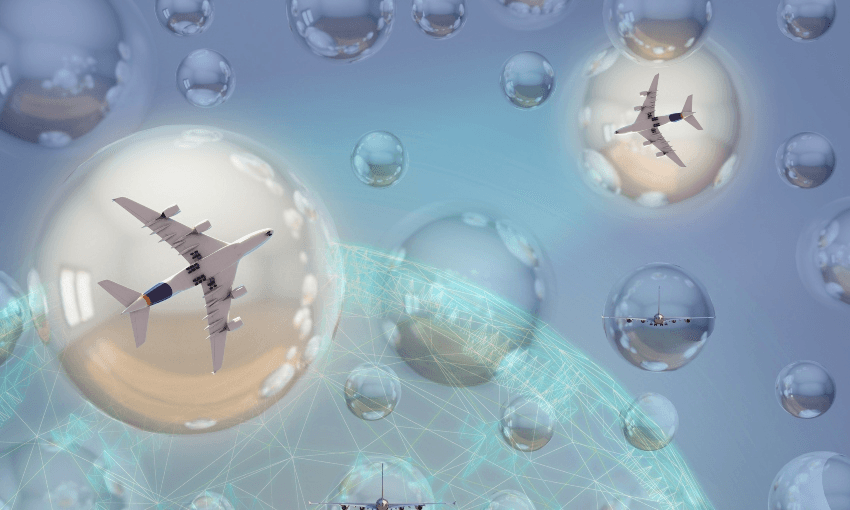A new New Zealand study offers some important lessons on how the coronavirus can spread aboard an aircraft.
One of the good things about New Zealand pursuing an elimination strategy for Covid-19 (aside from the obvious) is that we are able to help answer some of the questions there are about how the SARS-CoV-2 virus transmits between people. Take air travel. As many people in the US start to head off around the country to spend Thanksgiving with their friends and family, will some of them be spreading the virus on the journey? A new study suggests yes.
Before I get to the study, one important thing to note is that many airlines around the world now won’t let people board a plane unless they have a negative test a few days before they are due to travel. I’ve said it before, and I’ll say it again: that doesn’t guarantee people won’t be infectious on the plane. People can test negative but be infected and still in the incubation period. If they are, they run the risk of becoming infectious during the flight. Or their result may be a false-negative, perhaps because it was from one of the less sensitive tests. People can also genuinely be negative when they test but get infected just before they fly. Hopefully, they won’t become infectious on the plane, but it may well depend on how long their journey is. People typically become infectious anywhere from two to 10 days after they have been exposed to the virus. But there have been some cases where it looks like the incubation period was shorter than 24 hours. There are also media reports of a growing black market in fake negative test results.
Using genome sequencing to understand transmission
Toby Morris and I have explained before how sequencing the genomes of the SARS-CoV-2 virus can help to track how the virus is spreading. To summarise, the genetic material of the virus is a strand of RNA made up of almost 30,000 nucleotides. Those nucleotides – adenine, cytosine, guanine, and uracil – are more commonly known by their abbreviations, A, C, G, and U. They code for the amino acids that in turn give us the proteins that make up the virus. Each time the virus enters a new cell and replicates, its genetic material also needs to be copied. It’s here that errors can creep in, replacing the nucleotides that should be at a certain position. These errors are called mutations.
As the pandemic has progressed, different mutations are accumulating in the virus in different parts of the world. If you are interested in seeing how the virus is changing, check out the Nextstrain website. There is no solid evidence at the moment that these mutations are making the virus any more infectious or more or less deadly.
Dr Jemma Geoghegan is an evolutionary virologist at Otago University and ESR and one of the people behind New Zealand’s incredible efforts to sequence all the strains of the virus we get here. She and Tara Swadi from the Ministry of Health are lead authors on a new study that used genome sequencing to investigate the strains of seven of the 86 passengers who arrived in New Zealand on the same flight and then tested positive for the virus in managed isolation and quarantine. Had those seven people all been infected before they got on the plane or was there any transmission of the virus on their flight? The study is likely in the process of being peer-reviewed but they’ve made a pre-print version of it available on ESR’s website.
Transmission of Covid-19 on a long-haul flight
The seven passengers all travelled to New Zealand together on the same 18-hour flight from Dubai. They didn’t all start their journey in the United Arab Emirates, though. They originally came from all over the globe: India, Ireland, South Africa, Switzerland, and Ukraine.
If they had been infected in their countries of origin, then we would expect them to be carrying very different viruses, genetically speaking. They weren’t. The genomes of the viruses from the seven cases were identical, except for a single mutation in one case. That’s pretty clear evidence that one of the passengers must have been the source. Comparing the seven genomes with a database of more than 155,000 sequenced globally came up with a match to just six others. Four of the six were from Switzerland, the country of origin of two of the passengers who tested positive – referred to in the study as A and B. They were travelling together as part of a family group and tested negative roughly three days before they boarded the flight in Dubai. One of those passengers (A) was the first to report experiencing symptoms, suggesting they were the one who was infectious during the flight. All the other passengers who became infected were seated within two rows of passengers A and B. The good news is that eight other passengers who also sat near passenger A didn’t become infected.
While it is possible that the virus could have transmitted during check-in or while the passengers were boarding the plane, the fact they were all sat within a few rows of each other suggests transmission happened during the flight. Several of the passengers reported wearing masks, including passengers A and B, but there is no way they could have worn them for the entire flight. Eighteen hours is a long time.
So, in summary, people can definitely catch Covid-19 on a plane, whatever the airlines might say. But the question now is, how long does the flight need to be?

